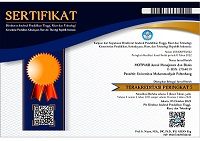Pengaruh Motivasi Wisatawan, Kualitas Layanan dan Persepsi Nilai terhadap Kepuasan Wisatawan (Studi Pada Wisatawan Domestik Di Kota Palembang)
Abstract
ABSTRACT
This study aims to examine the causality relationship between the motivation of tourists, the quality of service and the perception of value to the satisfaction of tourists. The population in this study are tourists who have visited in 4 attractions in the city of Palembang namely: Jaka Baring Sport City, Kemaro Island, Kuto Besak Fort and Kambang Iwak Park. The method of analysis used in this study is path analysis, To meet the minimum requirements of path analysis tool, the sample of the research is 180 respondents. The type of sampling used is purposive sampling. The results showed that there was no significant influence on the motivation of tourists to satisfy tourists. There is a significant influence on the quality of service to the satisfaction of tourists. There is a significant influence on the perception of value to the satisfaction of tourists.
Keywords
Full Text:
PDFReferences
Alqurneh, Majid., Md Isa, Filzah & Othman, Abdul Rahim. 2010. “Tourism destination image, satisfaction and loyalty: A study of the Dead Sea in Jordanian curative tourism”. Paper presented at The Third International Conference on International Studies (ICIS 2010), Hotel Istana Kuala Lumpur. College of Law, Government and International Studies, University Utara Malaysia. Sintok, pp. 1-10.
Artu?er, S., Cetinsoz, B., C., & K?l?c, I. 2013. The Effect of Destination Image on Destination Loyalty: An Application In Alanya // European Journal of Business and Management. 5 (13); pp. 124–136.
Bajs, I.P. 2015. Tourist Perecieved Value, Relationship to Satisfcation, and Behavior Intention, The example of the Croatian Tourist Destination Dubrovnik, Journal of Travel Research, 54, pp. 122-134.
Beard, J. G., & Ragheb, M. G. 1980. Measuring leisure satisfaction. Journal of Leisure Research, 12, pp. 20-33.
Chang, C. 2006. Segmenting tourists to aboriginal cultural festivals: An example in the Rukai tribal area, Taiwan. Tourism Management, 27 (1), pp. 1224-1234.
Charters, S., & Ali-Knight, J. 2002. Who is the wine tourist? Tourism Management, 23, pp. 311-319.
Coban, S. 2012. “The Effects of the Image of Destination on Tourist Satisfaction and Loyalty: The Case of Cappadocia”. European Journal of Social Science, 29 (2): pp.222-232.
Cole, S. T., & Crompton, J. L. 2003. A conceptualization of the relationships between service quality and visitor satisfaction, and their links to destination selection. Leisure Studies, 22 (1), pp. 65-80.
Cole, S. T., Crompton, J. L., & Willson, V. L. 2002. An empirical investigation of the relationships between service quality, satisfaction and behavioral intentions among visitors to a wild life refuge. Journal of Leisure Research, 34 (1), pp. 1-24.
Cole, S. T., & Scott, D. 2004. Examining the mediating role of experience quality in a model of tourist experiences. Journal of Travel and Tourism Marketing, 16, pp. 79-90.
Correia, A., Valle, P. O., & Moco, C. 2007. Modeling motivations and perceptions of Portuguese tourists. Journal of Business Research, 60, pp. 76-80.
Crompton, J. L. 1979. An assessment of the image of Mexico as a vacation destination and the influence of geographical location upon that image. Journal of Travel Research, 17 (4), pp. 18-24.
Crompton, J. L., & McKay, S. L. 1997. Motives of visitors attending festival events. Annals of Tourism Research, 24 (2), pp. 425-439.
Cronin J., Brady, & M., Hult, T., 2000. Assessing the Effects of Quality, Value, and Customer Satisfaction on Consumer Behavioral Intentions in Service Environments, Journal of Retailing 76: 193-218.
De Ruyter, Ko., Bloemer, José., & Peeters, Pascal. 1997. Merging Service Quality and Service Satisfaction. An Empirical Test of an Integrative Model. Journal of Economic Psychology, 18, pp. 387- 406.
De Ruyter, Ko., Bloemer, Josee., & Wetzels, Martin. 1998. "Customer Loyalty in a Service Setting", European Advances in Consumer Research, 3, pp. 162-169.
Fodness, D. 1994. Measuring tourist motivation. Annals of Tourism Research, 21 (3), pp. 555-581.
Grewal, Dhruv., Krishnan, Ram., Baker, Julie., & Borin, Norm. 1998. The Effect of Store Name, Brand Name and Price Discounts on Consumers' Evaluations and Purchase Intentions, Journal of Retailing, 74, pp. 331-352.
Gumussoy, Cigdem Altin & Koseoglu, Berkehan. 2016. The Effects of Service Quality, Perceived Value and Price Fairness on Hotel Customer s’ Satisfaction and Loyalty, Journal of Economics, Business and Management, 4 (90), pp. 523-527.
Havlena, William J. & Morris B. Holbrook. 1986. "The Varieties of Consumption Experience: Comparing Two Typologies of Emotion in Consumer Behavior," Journal of Consumer Research, 13, pp. 394-404.
Homburg, C., Jensen, O., & Krohmer, H., 2008. Configurations of marketing and sales: taxonomy. Journal of Marketing, 72 , pp. 133-154.
Hui, Eddie C.M. & Zheng, Xian. 2010. Measuring customer satisfaction of FM service in housing sector A structural equation model approach, Facilities, 28 (5/6), pp. 306-320.
Iso-Ahola, S. E., & Allen, J. R. 1982. The dynamics of leisure motivation: The effects of outcome on leisure needs. Research Quarterly for Exercise and Sport, 53 (2), pp. 141-149.
Izogo, Ernest Emeka & Ogba, Ike-Elechi. 2015. Service quality, customer satisfaction and loyalty in automobile repair services sector", International Journal of Quality & Reliability Management, 32 (3).
Jang, S. C.,&Wu, C.M. 2006. Seniors’ travel motivation and the influential factors: An examination of Taiwanese seniors. Tourism Management, 27, pp. 306-316.
Kane, M. J., & Zink, B. 2004. Package adventure tours: Makers in serious leisure careers. Leisure Studies, 23, pp. 329-345.
Kotler, Philip dan Gary armstrong, 2009, Prinsip-Prinsip Pemasaran, Edisi 12, jilid 2, Jakarta: Erlangga.
Kozak, M. 2002. Comparative analysis of tourist motivations by nationality and destinations. Tourism Management, 23, pp. 221-232.
Kozak, M., & Rimmington, M. 2000. Tourist satisfaction with Mallorca Spain as an off-season holiday destination. Journal of Travel Research, 38, pp. 260-269.
Kwun, J. W. 2004. Effects of brand, price and risk on customers’ value perceptions and behavior intentions in restaurant industry. Journal of Hospitality & Leisure Marketing, 11 (1), pp. 31-49.
Lee, C. K. 2000. A comparative study of Caucasian and Asian visitors to a cultural expo in an Asian setting. Tourism Management, 21 (2), pp. 169-176.
Lee, T. H. 2007. Ecotourism behavioral model of national forest recreation areas in Taiwan. International Forestry Review, 9 (3), pp. 771-785.
Lee, C. K., Yoon, Y. S., & Lee, S. K. 2007. Investigating the relationships among perceived value, satisfaction, and recommendations: The case of the Korean DMZ. Tourism Management, 28, pp. 204-214.
Lee, Y., Dattilo, J., & Howard, D. 1994. The complex and dynamic nature of leisure experience. Journal of Leisure Research, 26 (3), pp. 195-211.
Lertputtarak, S. 2012. The relationship between destination image, food image, and revisiting Pattaya, Thailand. International Journal of Business and Management, 7 (5), pp. 111–122.
Liang, D. 2008. The Determining Factors of Customer Loyalty for Luxury Hotels in US. The Journal of International Management Studies, 3 (2), pp. 167-175.
Lin, H. C., Morais, B. D., Kerstetter, L. D., & Hou , S. J. 2007. Examining the role of cognitive and affective image in predicting choice across natural, developed, and theme park destinations. Journal of Travel Research, 46 (2), 183–194.
Lovelock, C. & Wirtz, J. 2007. Services Marketing: People, Technology, Strategy, 6th international ed. Upper Saddle River: Pearson Prentice Hall.
Mannell, R. C., & Iso-Ahola, S. E. 1987. Psychological nature of leisure and tourism experience. Annals of Tourism Research, 14 (3), pp. 314-331.
McGehee, N.G., Loker-Murphy, L. & Uysal, M. 1996. The Ausltralian international pleasure travel market: Motivation from a gendered perspective, Journal of Tourism Studies, 7 (1), pp. 45-57.
McIntosh, R., & Gupta, W. S. 1977. Tourism: Principles, practices, philosophies (3rd ed), Columbus, OH: Grid Inc.
Mehmetoglu, M. 2007. Typologising nature-based tourists by activities—theoretical and practical implications. Tourism Management, 28, pp. 651-660.
Oppermann, M. 2000. Tourism destination loyalty. Journal of Travel Research, 39 (1),pp. 78-84.
Petrick, J. F. 2004. Are loyal visitors desired visitors. Tourism Management, 25 (5), pp. 463-470.
Prayag, Girish. 2008. “Image, Satisfaction and Loyalty – The Case of Cape Town”. Anatolia: An International Journal of Tourism and Hospitality Research, 19 (2): pp. 205-224.
Ross, E. L. D., & Iso-Ahola, S. E. 1991. Sightseeing tourists’ motivation and satisfaction. Annals of Tourism Research, 18 (2), pp. 226-237.
Salim, Issa Seif. 2016. The Link between Tourists’ Motivation, Perceived Value and Consumer Loyalty: The Case of Film Festival Branding in Zanzibar. International Journal of Business and Management Invention, 5 (10); pp. 18-28.
Santouridis, I, & Trivellas, P. 2010. Investigating the impact of service quality and customer satisfaction on customer loyalty in mobile telephony in greece. The TQM Journal, 22 (3), pp. 330-343.
Sato, Shintaro; Gipson, Christina; Todd, Samuel & Harada, Munehiko. 2017. The relationship between sport tourists’ perceived value and destination loyalty: an experience-use history segmentation approach, Journal of Sport & Tourism, pp. 1-14.
Setiawan, Heri., Sayuti, Jalaluddin & Lestari, Sari. 2016. Pengaruh Motivasi dan Atribut Destinasi terhadap Kepuasan dan Loyalitas Wisatawan Berkunjung ke Jaka Baring Sportcity Palembang. Laporan Penelitian Kerjasama Dosen-Mahasiswa, Politeknik Negeri Sriwijaya.
Sweeny, J.C., Soutar, G.N. & Johnson, L.W. 1999. The role of perceived risk in the quality–value relationship: a study in a retail environment. Journal of Retailing, 75, pp. 77-105.
Sweeney, Jillian C. & Geoffrey N. Soutar. 2001. “Consumer-Perceived Value: The Development of a Multiple Item Scale, Journal of Retailing, 77 (2), pp. 203-220.
Taylor, S., Celuch, K., & Goodwin, S. 2004. The importance of brand equity to customer loyalty. Journal of Product & Brand Management, 13 (4), pp. 217-227.
Tomas, S. R., Scott, D., & Crompton, J. L. 2002. An investigation of the relationships between quality of service performance, benefits sought, satisfaction and future intention to visit among visitor to zoo. Managing Leisure, 7, pp. 239-250.
Wang, X. & Leou, C. H. 2015. A study of tourism motivation, perceived value and destination loyalty for Macao cultural and heritage tourists. International journal of marketing studies. 7 (6), pp. 83-91.
Whisman, S. A., & Hollenhorst, S. J. 1998. A path model of whitewater boating satisfaction on the Cheat River of West Virginia. Environmental Management, 22, pp. 109-117.
Yoon, Y., & Uysal, M. 2005. An examination of the effects of motivation and satisfaction on destination loyalty: A structural model. Tourism Management, 26, pp. 45-56.
Yu, T. K., & Lee, N. H. 2001. The constructionalisation and verification of traveling satisfaction model: The case of northern Taiwan people traveling to Kinmen. Journal of Outdoor Recreation Study, 14 (4), pp. 51-76.
DOI: https://doi.org/10.32502/mti.v2i2.2043
Refbacks
- There are currently no refbacks.
Copyright (c) 2019 MOTIVASI Jurnal Manajemen dan Bisnis
Motivasi: Jurnal Manajemen dan Bisnis is Published by Management Department, Economic and Business Faculty, Muhammadiyah University of Palembang. This work is licensed under a Creative Commons Attribution-ShareAlike 4.0 International License.
Indexed/Abstracted






.png)
.png)



